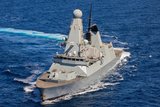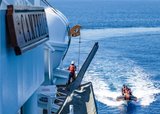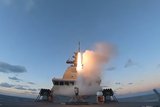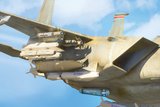Solving the puzzle of shaft line repairs (Studio)
Photo: Crown Copyright
Shaft lines can endure a range of problems, from everyday wear and tear to serious accidents. While each incident is unique, they must all be resolved as quickly as possible through the deployment of on-site expertise, global resources and technological innovation, according to Wärtsilä Shaft Line Repair Services (formerly Wärtsilä Seals & Bearings).
Marine incidents can have a number of impacts on shaft lines. A grounding or collision could compromise the entire vessel, for instance. While such incidents are mercifully rare, noise and vibration problems are common, as are leaking seals and deteriorating bearings.
Wärtsilä tackles these problems through its teams of project managers, field service engineers, alignment and measurement specialists, data analysts and more. Together they form Wärtsilä Shaft Line Repair Services.
The aim is to serve as the primary contact for customers when a problem occurs, said Project Manager Paula Villaverde. She likens her role to solving a puzzle, ‘pulling all the pieces together so that the customer can receive the support they require in the shortest time possible’.
A speedy response is key from a performance and safety perspective, while also bringing financial benefits, Villaverde said: every day the vessel is in dry dock costs money.
‘We try to provide the best solution in the shortest time possible,’ she said.

No matter the incident, project managers like Villaverde must oversee an appropriate response. This could involve dispatching service engineers, such as investigation specialists, on-site supervisors or seals and bearings experts. The aim is to deploy resources at speed, in close coordination with the customer.
Villaverde works closely with many field service resource managers like Selma Selamet, who ensure that Wärtsilä is able to deploy the right engineers at the right time. This could be at short notice or in advance, against the backdrop of constantly shifting docking schedules. Requests could come from project managers, sales or field service representatives, or directly from customers.
The precise response depends on the nature of the incident. For example, Selamet pointed to potential problems with the seal between the propeller shaft and the stern tube. If an engineer is required, Selamet will arrange for one to visit, investigate and report back their findings, which could prompt a more extensive repair.
But her work does not stop here – there may also be a need for spare parts, for example. She also works with design engineers to look at the best technical means of supporting customers, and project engineers to provide field support.
Villaverde also drew particular attention to Wärtsilä’s alignment services. This is crucial, ‘as every time an accident happens, most of the damage is in the shaft line alignment in the vessel’. In such incidents, the on-site presence of alignment experts can identify the root cause of problems and begin the search for solutions.
The project managers also coordinate the delivery of replacement/upgrade products, influencing production schedules and working with product experts globally to ensure the most suitable solution is prioritised in production to arrive as quickly as possible.
The alignment work takes place both in the company’s main office in Denmark and on site, with travelling engineers supported by in-house analysis, calculations, design reviews and more, said Jens Hyrup, alignment and measurement specialist.
His team ‘measures everything that is measurable’, from the load distribution in the system to vibrations. All of these measurements are then combined, allowing for a shaft model to be created and for remote calculations to be made from the onsite data.
This data analysis dimension is key to shaft line repair services today. Data analysts like Morten Mørch must sift through reams of information, attributing certain findings to particular conditions in the seals, bearings and other equipment.
This can be a challenging process on a vessel, Mørch explained.
‘When working on a floating object, the background noise is always changing – it’s not as easy as when it’s a land-based installation.’
Technology is enhancing the process, he said, with automated software reducing the time needed on each analysis. However, there will always be a need for a human analyst, he believes, as ‘you cannot rely totally on something that is automatically generated’.
More and more sensors are being installed on equipment, producing growing amounts of data. Far greater levels of predictive maintenance will be possible in the future, Hyrup said. This could extend service intervals, reducing the docking time faced by vessels.
Wärtsilä is pursuing a number of other technological innovations, said Selamet. She pointed to the use of augmented reality (AR) in the field service role, with engineers using AR goggles on some jobs, enhancing the data provided to their colleagues in the office and providing a better understanding of the onboard situation.
However, while technology will continue to evolve, one feature will remain constant, argued Villaverde: the need to provide customers with a single contact point for all shaft line incidents.
‘Our mission is to provide a full service to the customer from a single source, whenever they need us.’
More from Studio
-
![Precision on Demand: The New Age of Loitering Weapons (Podcast)]()
Precision on Demand: The New Age of Loitering Weapons (Podcast)
Loitering munitions provide vital capabilities in the disrupted and unpredictable modern battlespace, from real-time ISR to a virtually “on demand” strike capability. Rafael is looking to the future of the technology, empowering systems to operate with increasing autonomy in hostile environments.
-
![Defending the Fleet: Naval air defence in the drone era (podcast)]()
Defending the Fleet: Naval air defence in the drone era (podcast)
In an era of swarming drones, proliferating missiles and saturation attacks, naval air defence must combine cutting-edge effectiveness with low cost per intercept. Israel’s Rafael is applying its long expertise to help navies adapt to emerging threats, while looking to a future of laser technology – and beyond.
-
![Combat-proven capabilities: How precision-strike systems are evolving for tomorrow’s battlespace (podcast)]()
Combat-proven capabilities: How precision-strike systems are evolving for tomorrow’s battlespace (podcast)
Combat-tested technology is being reshaped to counter A2/AD threats, reduce reliance on GPS and enable faster, more autonomous targeting in complex environments. In this special podcast, experts explain how the evolving threat landscape is shaping next-generation strike capabilities.
-
![Energy evolution: How laser defence systems are powering the next phase of air defence (podcast)]()
Energy evolution: How laser defence systems are powering the next phase of air defence (podcast)
Laser-based air defence is moving from promise to deployment as global threats evolve. In this special podcast, we explore how high-energy laser systems are reshaping interception strategies.
-
![Intelligence advantage: How real-time GEOINT is reshaping military decision-making (Studio)]()
Intelligence advantage: How real-time GEOINT is reshaping military decision-making (Studio)
In today’s contested operational environment, adaptability is key. The new Geospatial-Intelligence as a Service (GEO IaaS) solution from Fujitsu and MAIAR empowers militaries by enabling intelligence advantage, combining advanced technology with human expertise to deliver actionable insights.
-
![Training Together: Unlocking Educational Excellence through Military and Industry Collaboration (Studio)]()
Training Together: Unlocking Educational Excellence through Military and Industry Collaboration (Studio)
Military training is ultimately about people. At Capita, training programmes are built on close engagement with partners, delivering an educational approach that can adapt to individual needs, cultivate leadership – and drive wider cultural change.

























